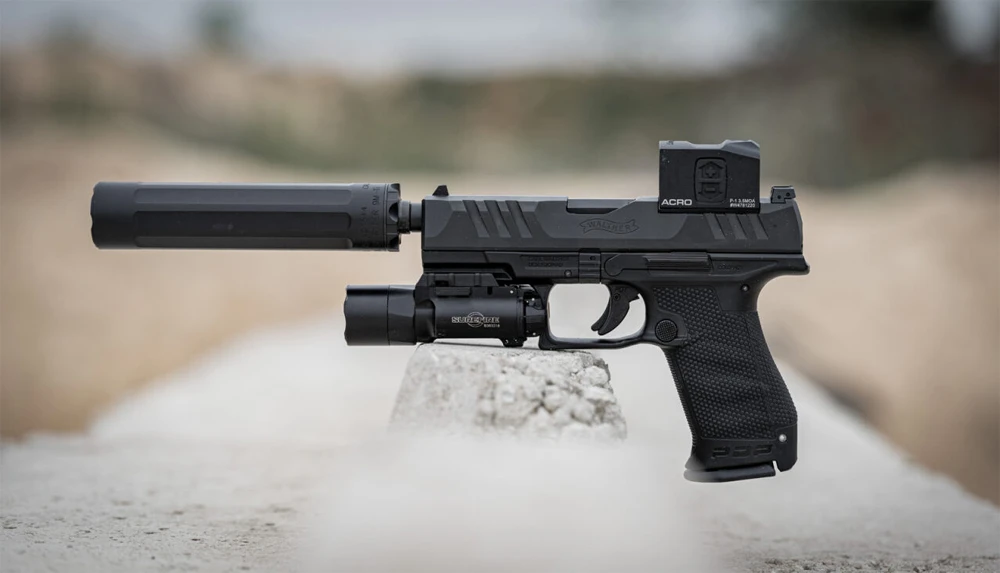

- Silencers are legal to own and possess in 42 states across the country, and you can move to these states with a silencer easily.
- Moving with a silencer does not require any additional ATF paperwork or approvals.
- Moving in-state while an AFT Form 4 is pending will not disrupt your paperwork from processing.
- Out-of-state with a silencer still pending approval can require a withdrawal, unless you have an NFA trust established.
- There are 8 states where silencers are prohibited and cannot be owned, try to avoid moving to these states.
If you’re moving with a suppressor, the rules are simpler than most people think. Below we cover suppressor laws, the ATF change of address form, and practical tips for transporting a suppressor across state lines during a permanent move.
Moving with a Suppressor: The Complete Guide
If you need to relocate and you currently own a silencer, or have one pending approval with the ATF, this guide is for you. In many cases, this process is very simple and requires little to no effort on your behalf. We’ll walk you through moving with an approved or pending item and moving in-state vs moving across state lines with a suppressor. We’ll even discuss states where possession of silencers may be unlawful, to ensure you know the rules and regulations concerning moving with a silencer.
NOTE: This is not intended as legal advice; state laws continually change so please review the current law in your state, or in the state you might be traveling to, and please consult with a licensed attorney in that state.
Table of Contents
Moving In State with a Suppressor
If you’re moving in state with a suppressor already approved, this is the best-case scenario. There is no paperwork or forms to fill out. As long as the county/city you’re moving to does not prohibit silencers, simply pack up and move into your new place. The ATF recommends filing out a Form 5320.20 to notify of a permanent change of address, but it is not required. For in-state moves, silencers require no special ATF approval; filing the ATF change of address form (Form 5320.20) is optional for suppressors and simply serves as a courtesy notice.
Moving Out of State with a Suppressor
If you are moving to another state with a suppressor and you already have an approved tax stamp, don't worry! As long as your destination recognizes suppressor laws, 42 states do, transporting a suppressor across state lines for a permanent move is legal without a 5320.20 for silencers. Again, the ATF would like you to fill out ATF Form 5320.20 when moving states with a suppressor, but it is not required for transporting silencers.
Transporting a Suppressor Across State Lines
Permanent relocation with a silencer does not require ATF Form 5320.20. Keep your tax stamp copy with the can, lock it securely, and comply with firearm-transport rules in both states.


Moving to Prohibited States with a Suppressor
Eight states and D.C. prohibit civilian suppressor possession (listed below). If your move involves one of these jurisdictions, review their suppressor laws and consider trust options or storage with a responsible person in a legal state.
Prohibited states include:
- California
- Delaware
- Hawaii
- Illinois
- Massachusetts
- New Jersey
- New York
- Rhode Island
- District of Columbia
A few states, such as Washington, prohibit use of a silencer with certain types of firearms but not with others, and do not outright prohibit possession of silencers. Even within states that prohibit possession of a suppressor, you still have options.
- If your silencer is registered to a trust, you can leave the silencer in your home state, where it is legal, with a responsible party named on your trust.
- Rethink your move; come to a free state like Texas.
- Dispose of the silencer. This should be a last-ditch effort (and be aware, ATF has very particular views on appropriate ways to dispose of NFA items).
Moving While Waiting For Your Suppressor
If you are moving within the same state, you are good to go. Once your Form 4 is approved, you can visit your dealer and pick it up as usual. There is nothing special for you to do if you’re moving to a new town in your current state of residence.
Pending Form 4 During a Move
If you are moving out of state with a pending ATF Form 4, it is a little less straightforward. You have two primary options: A responsible person of the NFA trust in the original state can receive the silencer once it is approved. Otherwise, you will have to withdraw your Form 4, have the silencer transferred to a new Powered by Silencer Shop dealer in the new state (assuming silencers are legal in the new state), and then resubmit your Form 4.
How to Notify the ATF of Change of Address
To be clear, Form 5320.20 does not apply to silencers, and does not need to be filled out when transporting suppressors, permanently or temporarily. However, if you want to submit this notification to the ATF, Form 5320.20 is simple and can be submitted electronically. In the past, these forms have taken about four weeks to be examined.
The best way to submit a Form 5320.20 is to access the form on ATF’s website, then email the completed form to NFAFAX@ATF.GOV.
Moving vs. Traveling with a Suppressor
This article covers permanent relocation and address changes. For short-term trips and airline/road tips, see our separate guide: Traveling with a Suppressor.
Conclusion
Moving with a silencer, or while a silencer is pending approval, doesn’t have to be scary. We’re here to make the NFA process as simple as possible and to give you all of the information you need to be a well-informed suppressor owner. In most cases, there is nothing for you to do when moving with a silencer, no forms, no documents, no headaches. In the instance that you’re moving to a new state, or to a prohibited state, there is a little more work to do. An NFA trust can be useful for keeping the silencer in a legal state.
Moving with a Suppressor FAQ
Is there an ATF change of address form for suppressors?
Yes, ATF Form 5320.20 exists, but for suppressors it’s optional. It’s a courtesy notification, not a required approval for a move.
Do I need a 5320.20 to transport a suppressor across state lines?
No. You may move a suppressor across state lines where legal without a 5320.20; keep a copy of your tax stamp with the can.
What’s different if I own an SBR or other NFA firearm?
Unlike suppressors, some NFA firearms (like SBRs) require an approved 5320.20 before interstate transport. Handle those items separately.
What if I’m moving to a state with different suppressor laws?
If your new state allows silencers, you’re fine. If it doesn’t, consider storing the item with a responsible person on your trust in a legal state or reevaluating the move.
Will moving in-state affect my pending Form 4?
No. In-state moves do not disrupt processing; just pick up at your dealer when approved.
Does my NFA trust need updates when I move?
If your address or responsible persons change, update trust documents so your records match reality and local law.
Where should I keep my tax stamp when moving?
Carry a digital or paper copy with the suppressor; store the original in a safe place.





